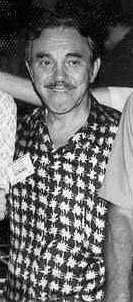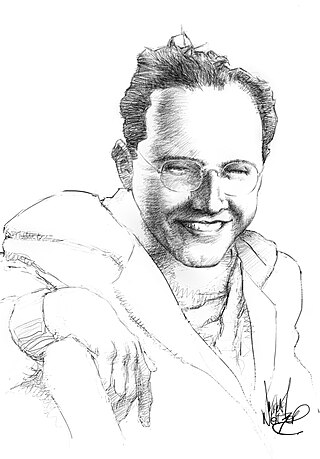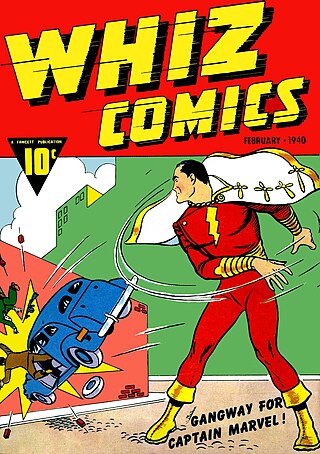
The Spirit is a fictional masked crimefighter appearing in American comic books. Created by cartoonist Will Eisner, he first appeared as the main feature of a tabloid-sized comic book insert distributed in the Sunday edition of Register and Tribune Syndicate newspapers. Popularly referred to as "The Spirit Section", the insert ran from June 2, 1940 to October 5, 1952.

Sheena, Queen of the Jungle, is a fictional American comic book jungle girl heroine, originally published primarily by Fiction House during the Golden Age of Comic Books. She was the first female comic book character with her own title, with her 1941 premiere issue preceding Wonder Woman #1. Sheena inspired a wealth of similar comic book jungle queens. She was predated in literature by Rima, the Jungle Girl, introduced in the 1904 William Henry Hudson novel Green Mansions.

Clarence Matthew Baker was an American comic book artist and illustrator, best known for drawing early comics heroines such as the costumed crimefighter Phantom Lady, and romance comics. Active in the 1940s and 1950s Golden Age of comic books, he is one of the first known African-American artists to find success in the comic-book industry. He also penciled St. John Publications' digest-sized "picture novel" It Rhymes with Lust (1950), the first graphic novel despite that term not having been coined at the time.
Notable events of 1938 in comics.
Morton Meskin was an American comic book artist best known for his work in the 1940s Golden Age of Comic Books, well into the late-1950s and 1960s Silver Age.

George Roussos, also known under the pseudonym George Bell, was an American comic book artist best known as one of Jack Kirby's Silver Age inkers, including on landmark early issues of Marvel Comics' Fantastic Four. Over five decades, he created artwork for numerous publishers, including EC Comics, and he was a staff colorist for Marvel Comics.

Samuel Maxwell "Jerry" Iger was an American cartoonist and art-studio entrepreneur. With business partner Will Eisner, he co-founded Eisner & Iger, a comic book packager that produced comics on demand for new publishers during the late-1930s and 1940s period known to fans and historians as the Golden Age of Comic Books.
"Charles Nicholas" is the pseudonymous house name of three early creators of American comic books for the Fox Feature Syndicate and Fox Comics: Chuck Cuidera (1915–2001), Jack Kirby (1917–1994), and Charles Wojtkoski (1921–1985). The name originated at Eisner & Iger, one of the first comic book packagers that created comics on demand for publishers entering the new medium during the 1930s–1940s Golden Age of comic books. The three creators are listed in order of birth year, below.

Louis Kenneth Fine was an American comic book artist known for his work during the 1940s Golden Age of comic books, where his draftsmanship became an influential model to a generation of fellow comics artists.

Fiction House was an American publisher of pulp magazines and comic books that existed from the 1920s to the 1950s. It was founded by John B. "Jack" Kelly and John W. Glenister. By the late 1930s, the publisher was Thurman T. Scott. Its comics division was best known for its pinup-style good girl art, as epitomized by the company's most popular character, Sheena, Queen of the Jungle.
Bob Powell was an American comic book artist known for his work during the 1930–1940s Golden Age of comic books, including on the features "Sheena, Queen of the Jungle" and "Mr. Mystic". He received a belated credit in 1999 for co-writing the debut of the popular feature "Blackhawk". Powell also did the pencil art for the bubble gum trading card series Mars Attacks. He officially changed his name to S. Robert Powell in 1943.

Tarzanesque is a term created by Frenchman Francis Lacassin used to describe characters in comic books inspired by Tarzan. A tarzanesque character resembles Tarzan in his physical resourcefulness, within a line of action that includes an adventurous life in the jungle, the gift of understanding and being understood by animals, contact with lost civilizations and courage combined with the ability to deal with nature. The creation of such characters may have been propitiated by the success that Tarzan had achieved since his appearance in literature in 1912, culminating with the release of daily comic strips in 1929, which paved the way for a genre that combined the allure of the unknown environment, the need for the archetypal characteristics of the hero and the popularity of access.

Blue Ribbon Comics is the name of two American comic book anthology series, the first published by the Archie Comics predecessor MLJ Magazines Inc., commonly known as MLJ Comics, from 1939 to 1942, during the Golden Age of Comic Books. The revival was the second comic published in the 1980s by Archie Comics under the Red Circle and Archie Adventure Series banners.
Eisner & Iger was a comic book packager that produced comics on demand for publishers entering the new medium during the late-1930s and 1940s, a period fans and historians call the Golden Age of Comic Books. Founded by Will Eisner and Jerry Iger, many of comic books' most significant creators, including Jack Kirby, entered the field through its doors. Eisner & Iger existed from 1936 to 1939.
Ruth Ann Roche was a writer and editor in the Golden Age of Comic Books. She was also the business partner of Jerry Iger.

Wings Comics was an aviation-themed anthology comic book published by Fiction House from 1940 to 1954. Wings Comics was one of Fiction House's "Big 6" comics titles.
Ann Brewster was an American cartoonist and illustrator during the Golden Age of comics. She provided art for many different publishers, including Ace Magazines, Fiction House, and Atlas Comics. Brewster is most notable for illustrating romance comics. After a career as penciller and inker for comics, she transitioned to illustrating novels and children's magazines before retiring in 1980.
Editors Press Service was a print syndication service of columns and comic strips that was in operation from 1933 to 2010. It was notable for being the first U.S. company to actively syndicate material internationally. Despite surviving for more than seven decades, EPS was never a large operation, characterized by comic strip historian Allan Holtz as a "hole-in-the-wall outfit."

The 1940s were an essential time for DC Comics. Both National Comics Publications and All-American Publications would introduce many new featured superheroes in American comic books in superhero comics anthology tales like More Fun Comics, Adventure Comics, Detective Comics, Action Comics, All-American Comics, Superman, Flash Comics, Batman, All Star Comics, World's Finest Comics, All-Flash, Star Spangled Comics, Green Lantern, Leading Comics, Sensation Comics, Wonder Woman, Comic Cavalcade and Superboy that would be a staple for the comic book company. Examples of the superheroes include the Flash, Hawkman and Hawkgirl, Johnny Thunder and Thunderbolt, Spectre, Hourman, Robin, Doctor Fate, Congo Bill, Green Lantern, Atom, Manhunter, Doctor Mid-Nite, Sargon the Sorcerer, Starman, Johnny Quick, the Shining Knight, the Star-Spangled Kid and Stripesy, Tarantula, Vigilante, Green Arrow and Speedy, Aquaman, Wonder Woman, Sandy, the Golden Boy, Mister Terrific, Wildcat, Air Wave, Guardian, Robotman, TNT and Dan the Dyna-Mite, Liberty Belle, Superboy and Black Canary. These characters would later crossover in superhero team titles in the 1940s such as the Justice Society of America and the Seven Soldiers of Victory helping pave a way to a shared universe of the publication company. Other used featured characters outside of superheroes included kid titular heroes like the Newsboy Legion and the Boy Commandos. Later Western heroes would be used such as Johnny Thunder, Nighthawk and Pow Wow Smith.
Comics packaging is a publishing activity in which a publishing company outsources the myriad tasks involved in putting together a comic book — writing, illustrating, editing, and even printing — to an outside service called a packager. Once the comics packager has produced the comic, they then sell it to the final publishing company.











